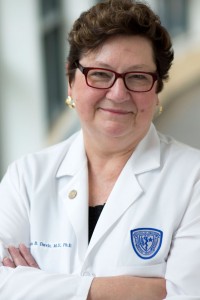Faculty and clinicians among those to reflect on CFTR gene discovery 25 years ago and on current treatment advances
The discovery of the cystic fibrosis (CF) gene was hailed as a trailblazing breakthrough in 1989. Now, on the 25th anniversary of the discovery of cystic fibrosis transmembrane conductance (CFTR) gene, more than two dozen CF innovators and clinicians, including five on the Case Western Reserve University campus, took this special occasion to reflect on the discovery and the status of research and treatment during videotaped interviews.
Much of these videotaped interviews with physicians, scientists, patients and families appeared Oct. 10 at a special satellite symposium, “Ahead of the Curve: CFTR at 25,” during the 28th annual North American Cystic Fibrosis Conference in Atlanta.
The satellite symposium was presented by continuing education firm DKBmed, LLC, in collaboration with Johns Hopkins University School of Medicine and The Institute for Johns Hopkins Nursing. All two dozen interviews conducted this past summer for “CFTR at 25” may be accessed online at aotc-cf.org/cftr25 or on YouTube’s eCysticFibrosis Review Channel.
Two of the interviewed Case Western Reserve School of Medicine faculty members played pioneering roles in cystic fibrosis research during the past 25 years. Pamela B. Davis, dean and senior vice president for medical affairs, served as director of the Adult Cystic Fibrosis Program at University Hospitals Case Medical Center before assuming duties as dean. Mitchell Drumm, professor of pediatrics and genetics and genome sciences, participated in the CFTR gene discovery process during his graduate studies at the University of Michigan.
Others interviewed from the Case Western Reserve campus represented the perspective of clinicians actively involved in a wide spectrum of CF patient care and research: James Chmiel, associate professor of pediatric pulmonology and clinician-researcher of CF inflammation at the School of Medicine and clinical director of pediatric pulmonology at UH Rainbow Babies & Children’s Hospital; and Colette Bucur, nurse practitioner and research coordinator of CF clinical trials, and Terri Schindler, nutritionist in CF care, both of UH Rainbow Babies & Children’s Hospital.
Additional interviews feature policymakers, leading educators and renowned researchers and clinicians from Johns Hopkins University, Stanford University, University of North Carolina, University of California San Diego, University of Wisconsin, National Institutes of Health (NIH), Cystic Fibrosis Foundation and Hebrew University of Jerusalem. Course Director Peter J. Mogayzel Jr., director of Johns Hopkins Cystic Fibrosis Center, selected interviewees based on their knowledge and experience to address CF research and advances in care. The interviewed CF patients and their families also put a human face on this illness by sharing their experiences.
CF is an illness where thick and sticky mucus builds up in airways and blocks digestive track passages. The CFTR gene controls the movement of salt and water in and out of the body’s cells. A faulty, or mutated, CFTR gene does not make the protein necessary to control the salt and water transport function, which triggers the excess mucus leading to cystic fibrosis.
In the 1950s, children with the illness rarely lived long enough to attend elementary school. Now, thanks to advances in treatment, the median survival is about 37 years after diagnosis. There have been reports, however, of CF patients living into their 70s.

“We believed, somewhat naively 25 years ago, that from the gene, a cascade of tremendous understanding about the pathobiology of the disease would take place and then a cure,” Davis said. “It turned out to be a complicated gene regulated by a number of factors.”
Davis credited “unprecedented collaboration and cooperation” nationally for creating imaginative grants that eventually led to identifying CFTR’s specific functions and how those were regulated. This far-reaching collaboration involved key research laboratories, major drug companies, the academic sector, the private sector, government agencies, particularly NIH, and “a very committed” Cystic Fibrosis Foundation. For her part in the discovery process, Davis worked on the concept that inflammation independently contributed to the pathobiology of CF lung disease, and, over the years, has published peer-reviewed journal papers on CF.
“Even though it took a long time to develop the first CF drug, many additional good discoveries came out of research on the CFTR gene,” Davis said. “I hope we can learn from this gene discovery experience about where the barriers were, and then for the next disease, we can make discoveries faster, better and cheaper.”
Another Case Western Reserve School of Medicine faculty member tells of his experiences with the CFTR gene discovery. Before joining the faculty at Case Western Reserve, Drumm worked as a budding scientist in the late 1980s in the lab of Francis Collins, who then led genetics research at the University of Michigan.
Drumm specifically worked on chromosome jumping, a cutting-edge technology at the time, to discover genes for which Collins had gained fame in the mid-1980s. It was an approach that led Collins to identify the CFTR gene in collaboration with Lap-Chee Tsui and John Riordan, both of Toronto Hospital for Sick Children. (Collins became director of NIH two decades later.)
“With the CFTR discovery, the original thought was to fix the gene and replace it,” Drumm said. “But we have since found that our methods to repair the gene were insufficient to trigger appropriate salt and water transport function that is faulty in cystic fibrosis. We have since discovered compounds that stimulate the salt and water transport channels, a finding that would not have occurred without the knowledge we gained from discovering the CFTR gene.”
Drumm praised Case Western Reserve’s prominent role in the history of CF research and treatment.
“We have such a unique environment here with MD clinicians and PhD bench scientists collaborating extensively on cystic fibrosis,” he said. “This is one of the few places with that kind of interaction to move discoveries to therapies.”
